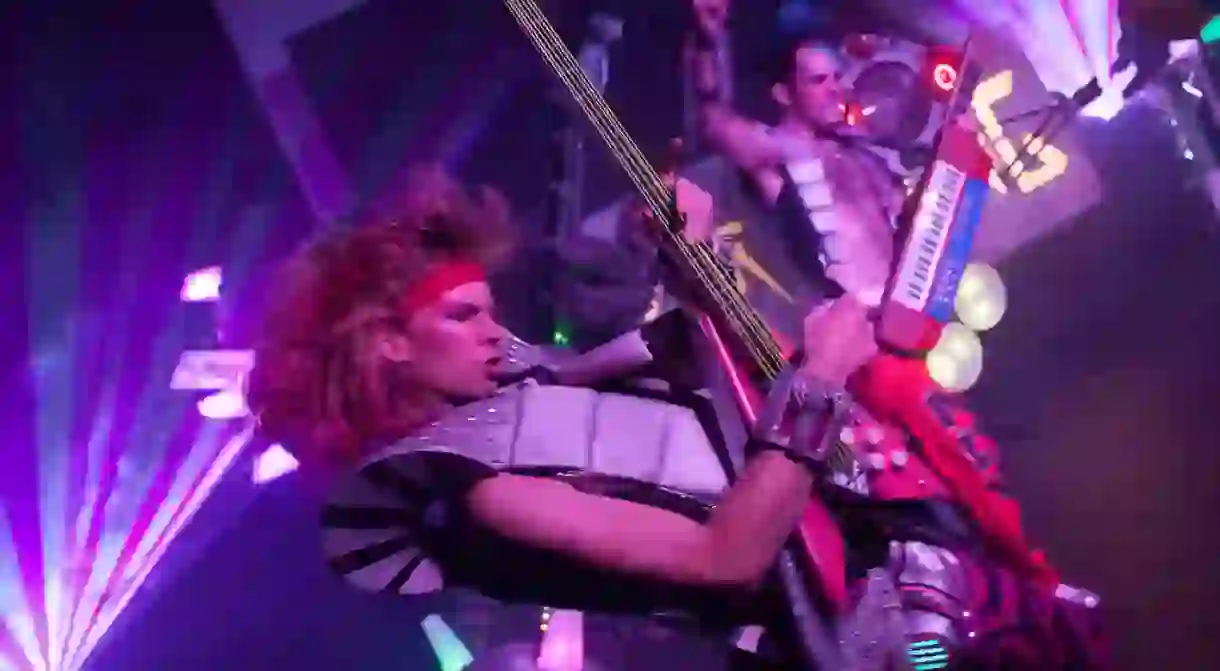This Baltimore Theater Company Creates Original Rock Operas

Fueled by a love for epic stories, electric guitar and beer, the homegrown rock operas made by the Baltimore Rock Opera Society are a mainstay of Baltimore’s arts scene, built by a dedicated community of volunteers.
Rock operas tell a dramatic story through interconnected rock songs – think Jesus Christ Superstar or The Who’s Tommy. But while most rock operas start out as concept albums, only staged and fleshed out if the album catches on, the non-profit Baltimore Rock Opera Society, or BROS, creates fully staged original rock operas from the ground up.
“BROS is a place where people with big ideas, tons of creativity and a desire to work really hard get together to build gigantic original rock musicals,” says executive director Aran Keating, one of the founding members of the troupe. “There is something really special about having 100+ people who all are sharing the vision of what a show could be and pouring out their blood, sweat and tears just to see a big crazy idea succeed and come to life on stage.”

The concept for the company began in 2007 when Keating and four others, most of them Goucher College graduates who had settled in the area and played in local rock bands, came together to tell an epic story through rock music. This story evolved into their first show, Gründlehämmer, produced in 2009.
BROS has since created 13 original stage productions, as of May 2018. While they don’t take themselves too seriously, with past productions involving demons, zombies, aliens and a magical electric guitar, they are nonetheless epic, combining performance, puppetry, elaborate sets and costumes, practical effects and an electric score incorporating a range of rock music.
“An original rock opera takes two to three years of development to go from the seed of an idea to opening night,” says Keating.
Those seeds come from the community, as anyone who has volunteered with the company is encouraged to pitch ideas for the next BROS show to their Artistic Council. The Artistic Council chooses a select few to expand into short pitches (five to 10 minutes) for the BROS Pitch Party, where volunteers and members vote on their favorite to produce.

From there, the writing and music teams take about a year to develop the script and score, before designers come in to create a vision for it. While the director casts the show and gets rehearsals underway, all the building, costume design and more are carried out by dozens of passionate volunteers.
“People understand that there is always something meaningful to do inside of BROS,” says Keating, “and that enables us to accomplish really big wonderful things.”
The support of the Baltimore arts community is also a significant part of the success of the Baltimore Rock Opera Society, as “about 2,000 ticket-buyers see each original show.” They also appear at events in Washington DC, Philadelphia and throughout the Baltimore area, such as Artscape and Light City.
The company even has their own beer, collaborating with popular Baltimore craft brewery The Brewer’s Art on “The Chuggernaut,” a specialty brew released in spring 2018.
Tom Creegan, co-owner of The Brewer’s Art, said in an article for Baltimore Magazine, “We just fell in love with the energy and creativity they bring to the city. They are so Baltimore.”
That community support has been necessary in recent years, as the company has been searching for a permanent home since their previous headquarters shut down in late 2016. They recently raised over $77,000 on Crowdrise towards future productions, the first phase in a larger plan to create what they call “Baltimore’s First Rock Palace” – a coworking space made by artists for artists.

In the meantime, the show must go on. Baltimore Rock Opera Society has mounted not one but two productions since the closure and is in early development for a rock opera set to premiere in 2020.
On what keeps them going, Keating says, “We really care about giving audiences unforgettable experiences by giving them the most epic story we can imagine and delivering it to your eyeballs.”
He concludes, “It’s the biggest, most elaborate show performed by people who put their hearts into the performance. What more could you want?”













